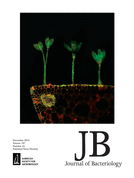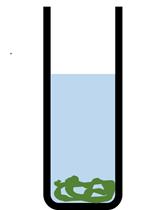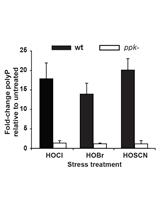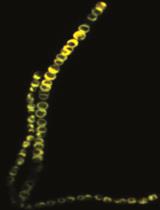- EN - English
- CN - 中文
Quantification of Hydrogen Sulfide and Cysteine Excreted by Bacterial Cells
定量测定细菌细胞分泌的硫化氢和半胱氨酸
发布: 2018年05月20日第8卷第10期 DOI: 10.21769/BioProtoc.2847 浏览次数: 6741
评审: Valentine V TrotterDarrell CockburnAnonymous reviewer(s)
Abstract
Bacteria release cysteine to moderate the size of their intracellular pools. They can also evolve hydrogen sulfide, either through dissimilatory reduction of oxidized forms of sulfur or through the deliberate or inadvertent degradation of intracellular cysteine. These processes can have important consequences upon microbial communities, because excreted cysteine autoxidizes to generate hydrogen peroxide, and hydrogen sulfide is a potentially toxic species that can block aerobic respiration by inhibiting cytochrome oxidases. Lead acetate strips can be used to obtain semiquantitative data of sulfide evolution (Oguri et al., 2012). Here we describe methods that allow more-quantitative and discriminatory measures of cysteine and hydrogen sulfide release from bacterial cells. An illustrative example is provided in which Escherichia coli rapidly evolves both cysteine and sulfide upon exposure to exogenous cystine (Chonoles Imlay et al., 2015; Korshunov et al., 2016).
Keywords: Hydrogen sulfide (硫化氢)Background
Reduced sulfur species are generated by microbes through several routes. Sulfate-reducing bacteria exploit the reductive process as an integral part of energy generation. Other bacteria release sulfide as a by-product of either the deliberate or adventitious degradation of sulfur species, including cysteine. We have observed that cysteine itself is excreted when intracellular levels are abnormally high, a situation that can occur through uncontrolled amino acid import or dysregulation of cysteine synthesis. These sulfur species are unusually reactive, as they bind metals with high avidity and also are among the few biomolecules that react chemically with molecular oxygen. The upshot is that reduced sulfur compounds can exert important effects upon cells. Hence, it can be important to track the dynamics of reduced sulfur compounds in a variety of contexts.
Thiol agents–notably, 5,5-dithiobis (2-nitrobenzoic acid) (DTNB)–provide good spectroscopic probes of thiol concentrations. Unfortunately, they do not discriminate between organic thiols like cysteine and inorganic species like hydrogen sulfide. The evolution of the latter species has often been detected using lead acetate strips, which are suspended in the head space over sulfide-generating cultures. However, this method is slow and non-quantitative. For that reason, we have leveraged the volatility of hydrogen sulfide so that standard dyes can allow sulfide and organic thiols to be distinguished as they are generated in lab cultures. The methods are simple, quick, and sensitive.
Materials and Reagents
- 10 ml test tubes, as necessary (Fisher Scientific, catalog number: 14-961-27 )
- Polypropylene tubes, 2 ml, as necessary (Denville Scientific, catalog number: C2170 )*
- Polypropylene 2 ml tubes, as necessary (see Material and Reagents #2)**
- Parafilm* (Bemis, catalog number: PM996 )
- Pipette tips (1,000 μl; 200 μl) (Corning, catalog number: 4846 ; USA Scientific, catalog number: 1111-1006 )
- Cylinder with compressed air (AirGas Mid-America, breathing quality grade D)
- Cylinder with compressed nitrogen (AirGas Mid-America)**
- 50 ml flasks (Corning, PYREX®, catalog number: 4442-50 )
- Flask closures (Fisher Scientific, catalog number: 05-888 )
- Bacterial cell culture
- Ethylenediamine tetraacetic acid, disodium salt, dihydrate, EDTA (Fisher Scientific, catalog number: S311 )
- Cystine dihydrochloride (Sigma-Aldrich, catalog number: C2526 )
- 5,5-Dithiobis (2-nitrobenzoic acid), DTNB (Sigma-Aldrich, catalog number: D8130 )
- 4-Amino-N,N-dimethylaniline, DMPDA (Sigma-Aldrich, catalog number: 07750 )
- Ferric(III) chloride hexahydrate (Sigma-Aldrich, catalog number: F2877 )
- Potassium phosphate, mono- or dibasic (Fisher Scientific, catalog numbers: P284 , P288 )
- Ethanol, 100% (Decon Labs, catalog number: 2716 )
- Potassium hydroxide (Fisher Scientific, catalog number: P250 )
- Glucose (Fisher Scientific, catalog number: D16 )
- Ammonium sulfate (Fisher Scientific, catalog number: A702 )
- Sodium citrate (Fisher Scientific, catalog number: S279 )
- Hydrochloric acid (Sigma-Aldrich, catalog number: H1758 )
- Sodium sulfide nonahydrate (Sigma-Aldrich, catalog number: S4766 )
- Magnesium sulfate heptahydrate (Fisher Scientific, catalog number: M63 )
- Deionized water (University of Illinois deionizing system)
- Stock solutions (see Recipes)
*These items are for DMPDA-based measurements.
**These items are for DTNB-based measurements.
Equipment
- For DMPDA-based measurements
- Pipettors, 1 and 0.2 ml (Mettler-Toledo, Rainin, catalog numbers: 17014382 , 17014384 )
- Microcentrifuge (Fisher Scientific, model: accuSpinTM Micro 17 , catalog number: 13-100-675)
- Spectrophotometer (Beckman Coulter, model: DU-640 )
- Shaking water bath (New Brunswick Scientific, model: G76D )
- Heater (Fisher Scientific, catalog number: 11-718 )
- Pipettors, 1 and 0.2 ml (Mettler-Toledo, Rainin, catalog numbers: 17014382 , 17014384 )
- For DTNB-based measurements
- Two 125 ml gas washing bottles with coarse fritted discs (Corning, PYREX®, catalog number: 31760-125C )
- Water bath (Shel-Lab, VWR, model: Model 1250 )
- Two 125 ml gas washing bottles with coarse fritted discs (Corning, PYREX®, catalog number: 31760-125C )
Procedure
文章信息
版权信息
© 2018 The Authors; exclusive licensee Bio-protocol LLC.
如何引用
Korshunov, S. and Imlay, J. A. (2018). Quantification of Hydrogen Sulfide and Cysteine Excreted by Bacterial Cells. Bio-protocol 8(10): e2847. DOI: 10.21769/BioProtoc.2847.
分类
微生物学 > 微生物生理学 > 胁迫反应
微生物学 > 微生物新陈代谢 > 营养运输
生物化学 > 其它化合物 > 硫醇
您对这篇实验方法有问题吗?
在此处发布您的问题,我们将邀请本文作者来回答。同时,我们会将您的问题发布到Bio-protocol Exchange,以便寻求社区成员的帮助。
提问指南
+ 问题描述
写下详细的问题描述,包括所有有助于他人回答您问题的信息(例如实验过程、条件和相关图像等)。
Share
Bluesky
X
Copy link












